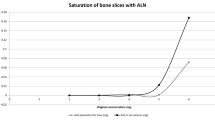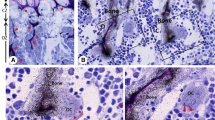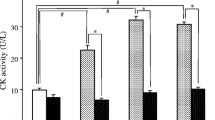Summary
Bisphosphonates are nonbiodegradable pyrophosphate analogues that are being used increasingly to inhibit bone resorption in disorders characterized by excessive bone loss. We have previously found that dichloromethylene bisphosphonate (Cl2MBP) inhibits bone resorption through injury to the cells that resorb Cl2MBP-contaminated surfaces. 3-amino-1-hydroxypropylidene-1,1-bisphosphonate (AHPrBP) is a more potent inhibitor of bone resorptionin vivo, and we have attempted to identify a step in the resorptive pathway that accounts for this increased potency. We found that when osteoclasts, isolated from neonatal rat long bones, were incubated on bone slices in the presence of bisphosphonates, AHPrBP was less, rather than more potent as a resorption-inhibitor than Cl2MBP. The greater sensitivity of resorption to AHPrBPin vivo could neither be attributed to an effect of AHPrBP on the ability of osteoblastic cells to stimulate resorption in response to calcium-regulating hormonesin vitro nor to an effect on osteoclast generation: osteoclast formation was unaffected by concentrations of AHPrBP 10-fold higher than those of Cl2MBP which inhibit bone resorption in the bone slice assay. We also found no evidence for impaired osteoclast generationin vivo in AHPrBP-treated rats. These results suggest that the comparisons of potencyin vitro do not include all the factors responsible for determining bisphosphonate potencyin vivo. Because bisphosphonates owe the specificity of their actions to their ability to bind to bone surfaces, we performed experiments using bone slices that had been immersed in bisphosphonates before use. Bone resorption was virtually abolished on bone slices preincubated in 10−3 M AHPrBP. Inhibition was associated with degenerative changes in osteoclasts and a more rapid decrease in the number remaining on the bone surface than occurred with Cl2MBP. The effect was specific for osteoclasts, could be prevented if bone resorption was suppressed by calcitonin, and was not seen in osteoclasts incubated in AHPrBP on plastic coverslips. These observations suggest that AHPrBP inhibits bone resorption through injury to osteoclasts when they solubilize bisphosphonate-contaminated bone. We found that the concentration of AHPrBP used in the preincubation phase could be reduced by an order of magnitude if the volume of the AHPrBP solution was correspondingly increased. This implies that the concentration of bisphosphonate is less relevant to potency comparisons than the density of bisphosphonate on the bone surface. The latter will be strongly influencedin vivo not only by affinity for bone but by the pharmacokinetic and other properties of the compound.
Similar content being viewed by others
References
Jung A, Bisaz S, Fleisch H (1973) The binding of pyrophosphate and two diphosphonates on hydroxyapatite crystals. Calcif Tissue Res 11:269–280
Miller SC, Jee WSS (1979) The comparative effects of dichloromethylene diphosphonate (Cl2MDP) and ethane-1-hydroxy-1,1-diphosphonate (EHDP) on growth and modelling of the rat tibia. Calcif Tissue Res 23:207–214
Reitsma PH, Bijvoet OLM, Verlinden-Ooms H, Van der Wee-Pals JA (1980) Kinetic studies of bone and mineral metabolism during treatment with (3-amino-1-hydroxypropylidene)-1,1-bisphosphonate (APD) in rats. Calcif Tissue Int 32:145–157
Schenk R, Merz WA, Muhlbauer R, Russell RGG, Fleisch H (1973) Effects of ethane-1-hydroxy-1,1-diphosphonate (EHDP) and dichloromethylene diphosphonate (Cl2MDP) on the calcification and resorption of cartilage and bone in the tibial epiphysis and metaphysis of rats. Calcif Tissue Res 11:196–214
Altman RD, Johnston CC, Khairi MRRA, Wellman H, Serafini AN, Sankey RR (1973) Influence of sodium etidronate on clinical and laboratory manifestations of Paget's disease of bone (osteitis deformans). N Engl J Med 289:1379–1384
Douglas DL, Duckworth T, Russell RGG, Kanis JA, Preston CJ, Preston FE, Prenton MA, Woodhead JS (1980) Effect of dichloromethylene diphosphonate in Paget's disease of bone and hypercalcaemia due to primary hyperparathyroidism or malignant disease. Lancet i:1043–1047
Fleisch H (1982) Bisphosphonates: mechanisms of action and clinical applications. In: Peck WA, (ed) Bone and mineral research Annual I, 1. Excerpta Medica. Amsterdam, pp 319–357
Frijlink WB, Bijvoet OLM, Te Velde J, Heynen G (1979) Treatment of Paget's disease of bone with (3-amino-1-hydroxypropylidene)-1,1-bisphosphonate (APD). Lancet i:799–803
Ralston SJ, Gardner MD, Dryborough FJ, Jenkins AS, Cowan RA, Boyle IT (1985) Comparison of aminohydroxypropylidene diphosphonate, mithramycin and corticosteroids/calcitonin in treatment of cancer associated hypercalcaemia. Lancet ii:907–910
Sleeboom HP, Bijvoet OLM, van Oosteron AJ, Gleed JH, O'Riordan JHL (1983) Comparison of intravenous (3-amino-1-hydroxypropylidene)-1,1-bisphosphonate and volume repletion in tumour-induced hypercalcaemia. Lancet i:239–243
Huaux JP, Devogelaer JP, Brasseu JP, Nagant de Deuxchaisnes C (1985) Effect of the diphosphonate APD on dual photon absorptiometry in involutional osteoporosis. In: Norman AW (ed) Vitamin D. A chemical, biochemical and clinical update. Walter de Gruyter, Berlin, pp 998–999
Reginster JW, Lecart MP, Deroisy R, Sarlet N, Denis D, Ethagen D, Collette J, Franchimont P (1989) Prevention of bone loss by bisphosphonate. Lancet ii:1469–1471
Reid IR, King AR, Alexander CJ, Ibbertson HM (1988) Prevention of steroid-induced osteoporosis with (3-amino-1-hydroxypropylidene)-1,1-bisphosphonate (APD). Lancet 1:143–146
Fleisch H, Maerki J, Russell RGG (1966) Effect of pyrophosphate on dissolution of hydroxyapatite and its possible importance in calcium homeostasis. Proc Soc Exp Biol Med 122:317–320
Russell RGG (1975) Diphosphonates and polyphosphonates in medicine. Br J Hosp Med 14:297–314
Shinoda H, Adamek G, Felix R, Fleisch H, Schenk R, Hagan P (1983) Structure-activity relationships of various bisphosphonates. Calcif Tissue Int 35:87–99
Flanagan AM, Chambers TJ (1989) Dichloromethylenebisphosphonate (Cl2MBP) inhibits bone resorption through injury to osteoclasts that resorb Cl2MBP-coated bone. Bone Miner 6: 33–43
Rowe DJ, Hausmann E (1976) The alteration of osteoclast morphology by diphosphonates in bone organ culture. Calcif Tissue Res 20:53–60
Ende JJ (1978) Some effects of EHDP and Cl2MDP on the metabolism of isolated bone cells. Proc Kon Med Akad Wet C81:252–264
Ende JJ, van Rooijen HJM (1979) Some effects of EHDP and Cl2MBP on enzyme activiyt and substrate utilisation by mouse calvaria in tissue culture. Proc Kon Med Akad Wet C. 82:55–63
Felix R, Fast DK, Sallis JD, Fleisch H (1980) Effect of diphosphonates on glycogen content of rabbit ear cartilage cells in culture. Calcif Tissue Int 30:163–166
Felix R, Russell RGG, Fleisch H (1976) The effect of several diphosphonates on acid phosphohydrolases and other lysosomal enzymes. Biochim Biophys Acta 429:429–438
Guenther HL, Guenther HE, Fleisch H (1981) The effect of 1,hydroxymethane-1,1-diphosphonate and dichloromethylene-diphosphonate on collagen synthesis by rabbit articular chondrocytes and rat bone cells. Biochem J 196:293–301
Boonekamp PM, van der Wee-Pals LJA, van Wijk-von Lennep MML, Thesingh CW, Bijvoet OLM (1986) Two modes of action of bisphosphonates on osteoclastic resorption of mineralised matrix. Bone Miner 1:27–39
Hughes DE, MacDonald BR, Russell RGG, Gowen M (1989) Inhibition of osteoclast-like cell formation by bisphosphonates in long-term cultures of human bone marrow. J Clin Invest 83:1930–1935
Lowik CWGM, Van der Pluyin G, Van der Weel-Pals LJA, Bloys van Treslong-de Groot H, Bijvoet OLM (1988) Migration and phenotypic transformation of osteoclast precursors into mature osteoclasts: the effect of a bisphosphonate. J Bone Miner Res 3:185–192
Chambers TJ, Thomson BM, Fuller K (1984) Effect of substrate composition on bone resorption by rabbit osteoclasts. J Cell Sci 70:61–71
Chambers TJ, Magnus CJ (1982) Calcitonin alters behaviour of isolated osteoclasts. J Pathol 136:27–39
McSheehy PMJ, Chambers TJ (1986) Osteoblastic cells mediate osteoclastic responsiveness to parathyroid hormone. Endocrinology 118:824–828
Tobias J, Chambers TJ (1989) Glucocorticoids impair bone resorptive activity and viability of osteoclasts disaggregated from neonatal rat long bones. Endocrinology 125:1290–1295
Body JJ, Magritte F, Seraj JP, Sculier JP, Borkowski A (1989) Aminohydroxypropylidene bisphosphonate (APD) treatment for tumour-associated hypercalcaemia. A randomized comparison between a 3 day treatment and a single 24 hour infusion. J Bone Miner Res 4:923–928
Thiébaud E, Jaeger P, Burckhardt P (1987) Paget's disease of bone treated in five days with AHPrBP (APD) per os. J Bone Miner Res 2:45–52
Ralston SH, Gallagher SJ, Patel U, Dryburgh FJ, Fraser WD, Cowan RA, Boyle IT (1989) Comparison of three intravenous bisphosphonates in cancer-associated hypercalcaemia. Lancet ii:1180
Marie PJ, Holt M, Garba M-T (1985) Inhibition by aminohydroxypropylidene hisphosphonate (AHPrBP) of 1,25(OH)2D3-induced stimulated bone turnover in the mouse. Calcif Tissue Int 37:268–275
Stutzer A, Trechsel U, Fleisch H, Schenk R (1987) Effect of bisphosphonates on osteoclast number and bone resorption in the rat (abstract). J Bone Miner Res 266
de Vernejoule MC, Pointillart A, Bergot C, Bielakoff J, Morieux C, Laval Jeantet AM, Miravet L (1987) Different schedules of administration of (3 amino-1-hydroxypropylidene)-1,1-bisphosphonate induce different changes in pig bone remodelling. Calcif Tissue Int 40:160–165
Hattersley G, Chambers TJ (1989) Generation of osteoclastic function in mouse bone marrow cultures: multinuclearity and tartrate-resistant acid phosphatase are unreliable markers for osteoclastic differentiation. Endocrinology 124:1689–1696
Carano A, Teitelbaum SL, Konsek JD, Schlesinger PH, Blair HC (1990) Bisphosphonates directly inhibit the bone resorption activiyt of isolated avian osteoclasts in vitro. J Clin Invest 85:456–461
Mönkkönen J, Ylitalo P, Elo HA, Airaksinen MM (1987) Distribution of [14C]clodronate (dichloromethylene bisphosphonate) disodium in mice. Toxicol Appl Pharmacol 89:287–292
Daley-Yates PT, Bennett R (1988) A comparison of the pharmacokinetics of14C-labelled APD and 99mTc-labelled APD in the mouse. Calcif Tissue Int 43:125–127
Yakatan GR, Poynor WJ, Talbert RL, Floyd BF, Slough CL, Ampulski RS, Benedet JJ (1982) Clodronate kinetics and bioavailability. Clin Pharmacol Ther 31:402–410
Author information
Authors and Affiliations
Rights and permissions
About this article
Cite this article
Flanagan, A.M., Chambers, T.J. Inhibition of bone resorption by bisphosphonates: Interactions between bisphosphonates, osteoclasts, and bone. Calcif Tissue Int 49, 407–415 (1991). https://doi.org/10.1007/BF02555852
Received:
Issue Date:
DOI: https://doi.org/10.1007/BF02555852




